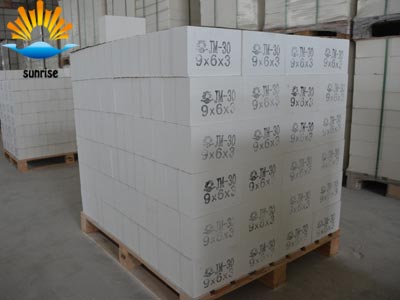Refractory knowledge
- The origin and development of refractory
- Improve the service life of chrome corund
- How to improve the insulation performance
- The production process of Refractory Bric
- Introduction to the production process of
- The impact of Sino-US trade war on the re
- Physical properties of refractory materia
- Lightweight fire brick performance
Hot Products
Classification of insulation materials
The thermal conductivity of the insulating material is less than 0.23 W/(m·°C), and its porosity is generally above 70%. Due to the large amount of gas enthalpy L, the bulk density is small (usually below 0.5 g/c rr13) and the mechanical strength is low. Is a common feature of various insulation materials. There are many types of insulation materials, which can be divided into three categories: high temperature (above 1200°C) insulation materials, medium temperature (900~1100°C) insulation materials, and low temperature (below 900°C) insulation materials, depending on the use temperature.
First, high temperature insulation material
The aforementioned lightweight clay bricks, lightweight high alumina bricks, lightweight alumina bricks, lightweight silica bricks, alumina refractory hollow spheres, and various refractory fiber products are all high temperature insulation materials.
Second, the temperature insulation material
1, ultra-lightweight perlite products
The ultra-lightweight perlite product is a high-grade insulation material with a very small density (as small as 60 kg/rr13) that can be used as a powder material after the natural rock is calcined and the volume is greatly expanded. Between the furnace masonry and the furnace shell), but mostly adding water glass, cement or phosphoric acid and other cementing agent, forming, baking and other processes, made of insulating bricks or insulation particles used.
Phosphoric acid bonded perlite insulation bricks have the best performance, the use temperature can reach 1000°C, the density is only 200kg/m3, and the thermal conductivity coefficient is also very small (0.05±0.29×10tW/(m·°C)). Perlite bricks cemented with cement and water glass have poor refractoriness. The former uses a temperature of 800°C and the latter 650°C.
2, rock
The meteorite is a mica-like mineral whose chemical composition is (MgFe)2. (H20) 2. (SiAlFe) 4010.4H20, Melting point 1300~1370°C.
When the vermiculite minerals are heated, the volume expands greatly and becomes a bulk material with a very small bulk density (0.1~0.3 g/cm3), which is called expanded vermiculite. Its allowable working temperature up to 1000 aC, thermal conductivity is very small (0.05 ~ 0.06W / (m · °C)), is a good insulation material.
Expanded vermiculite is mixed with a suitable amount of bauxite cement, water glass or bitumen as a cementing agent and can be made into insulating bricks. However, due to the addition of cement, the use properties have been reduced. For example, the use temperature of water glass gangue brick is reduced to 800°C, the thermal conductivity is 0. 08~0.10W/(m·°C), and the bulk density is increased to 0.4~0.45g/cm3. The bulk density is large, the furnace bricks absorb heat, and the heat storage loss is small.
3, ultra light clay brick
The bulk density of clay bricks such as ultra lightweight high alumina bricks is 0.3 to 0.4 g/cm3, and the thermal conductivity is 0. 23 W/(m·°C), which is a good medium temperature insulation material.
Third, low temperature insulation material
1, diatomaceous earth
Diatomaceous earth is a kind of porous mineral formed after the algae organism is corrupted in the earth's crust. Its main component is Si02, and contains a small amount of clay and other impurities.
The diatomaceous earth powder has a bulk density of 0.6 to 0.68 g/cm3, and a thermal conductivity of 0. 186 to 0. 23 W/(m.degree. C.) at 500 DEG C., and can be used as a heat-retaining filler material.
The ultra-light diatomaceous earth bricks are mainly made of calcined diatomaceous earth brick clinker, and then added with diatomite or clay as a binding agent. Bricks made of clinker, the volume residual shrinkage when used small. Diatomite insulation material is divided into A, B, C three grades, A grade performance is best, the density is (500 ± 50) kg / m3, apparent porosity is 78.3%, thermal conductivity (0.07 + 0. 21 ) x10 -3t. The use temperature of three grades of diatomaceous earth bricks is below 900°C, and the insulation performance is worse than that of vermiculite.
2, asbestos
Asbestos is a serpentine or amphibole-like mineral with a tough and strong fibrous structure. Its chemical composition is magnesium, iron, and some hydrated silicates such as calcium and sodium. Its molecular formula is 3Mg0.2Si02·2H20. Asbestos has a small bulk density and thermal conductivity, such as the bulk density of an asbestos powder is below 0. 6g/crj13, the thermal conductivity is less than 0. U7W/(m·°C) is a material with better thermal insulation properties. However, the heat resistance of asbestos is poor, and the loss of strength due to loss of crystal water occurs at 500°C, and it shrinks when heated to 700 to 800°C.









